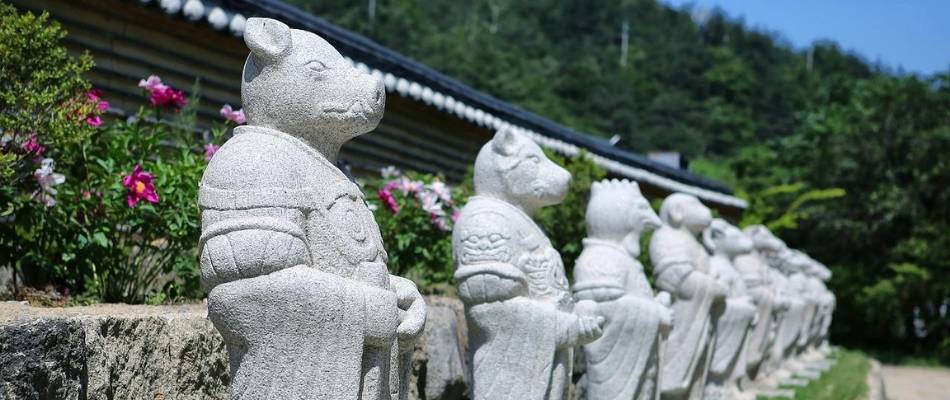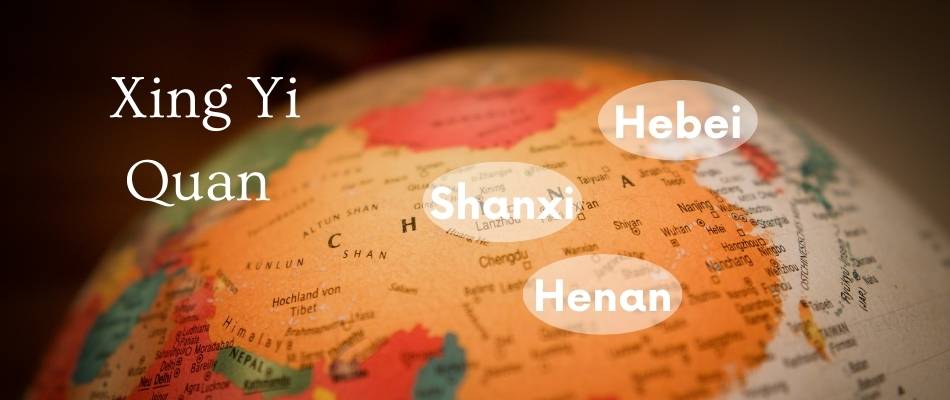What do you get when you remove the angles from tai chi and the circles from Bagua and put all your intention into linear attacks? You get Xing Yi Quan, a lesser-known internal martial art that has a lot to teach us about how to move externally while maintaining an internal focus.
Xing Yi Quan (形意拳 Hsing-I Chuan) or “Form-Intention Fist (Boxing)” is the oldest of the three primary internal Chinese martial arts. Its characteristically powerful, explosive, linear attacks originated from spear fighting and are taught in sequences based on the five elements.
Xing Yi Quan has some really important lessons for those of us studying tai chi, bagua, or any form of meditation. It gives us an example of what concentration and focus look like at a high level. Xing Yi shows us how an activity can simultaneously be physically demanding while maintaining internal calm. It also is the best internal martial art for demonstrating the connection between the mind and the body.
So let’s take a walk through its fascinating history and describe what the art is today. Words alone cannot explain how unique and powerful this art is. So, here’s a video of a gold medalist performing the xing yi quan forms.
What Does Xing Yi Quan Mean?
Xing Yi Quan is most commonly translated as Form-Intention Fist. The pronunciation of Xing Yi Quan does not match that spelling so it is sometimes written Hsing-I Chuan which you can hear pronounced correctly here: Google Translate Xing Yi Quan.
Looking more closely at the characters used gives us a greater understanding of what Xing Yi Quan means:
- 形 Xing: most accurately is “body” but is also used as form, shape, and is included in exemplar
- 意 Yi: means “intention” but this character also is meaning and is part of significance
- 拳 Quan: as in “taiji quan,” quan directly translates to “fist” but is also used as boxing to denote a style of fist work.
What do we get when we put that all together? It’s an exemplary form of body movements that have been designed to develop internal intent and maintain this intention while moving. Being an advance concept, an entire martial art system has been designed and organized to facilitate learning.
That is the beauty of Chinese, so much meaning in so few of characters!
The Development and History of Xing Yi Quan
Like every good martial arts origin story, the early days of the history of xing yi quan are wrapped in a bit of mysticism and heated debate about who created the art and when it came about. Then more recently, we have documentation, photos, videos, and definite lineages. Trying to get to the “exact” truth is not possible and frankly takes the fun out of it. Here are some thoughts on Xing Yi’s origin:
- Xing Yi was originally developed by Song Dynasty General, Yue Fei (1100s) who incorporated military fighting tactics into an open-handed internal art.
- Xing Yi Quan is not an original art but is actually an advancement on the animal forms from gong fu taught at Sholin Temple
- Ji Jike (Ji Longfeng), an accomplished martial artist from the 1600s, created Xing Yi based on principles of spear fighting. His documented work was codified as Heart – Intention Boxing (Xin Yi).
- In the 1800s, Li Luoneng became a student of one of the greatest lineage holders at the time, Dai Wenxiong. He mastered the art, further developed the 5 Element and 12 Animal sequences, and renamed it to Form – Intention Boxing (Xing Yi).
There is a fifth theory that I like the most because it includes all the possibilities above. When Ji Jike was an adult, China fell under Manchu rule who were the descendants of General Yue Fei. Ji Jike was in the upper class, began classical studies, martial arts studies, and worked in the Manchu government. In his travels he visited Shaolin Temple where he ended up staying for a decade.1 You can see how a noted expert in the martial arts and specifically spear fighting who was exposed to military texts and the gong fu of Shaolin Temple might have a unique perspective on how to fight and stay healthy. This was perfected for a couple of generations during the 1700s wherein Li Luongeng took all that was learned before him and painted the final picture.
The truth within the history of xing yi quan is that an incredibly unique and powerful art was developing by the 1800s. It is very advanced from a martial and meditative standpoint, so it had to have been refined over decades if not centuries.
By the beginning of the 1900s, several prominent families taught Xing Yi Quan with the styles being named after their place of origin: Hebei, Henan, and Shanxi Xing Yi. It was taught to military cadets during the war with Japan and we see its influence on tai chi when Xing Yi master Sun Lutang combined aspects of the art with Yang style to create Sun Style Tai Chi Chuan.
While it began being taught in the West after the cultural revolution, it has never gained the popularity of other competitive wushu styles or made it on the big screen.

Xing Yi Quan Training: From Standing, to Stepping, to 5 Elemental Attacks, to Multiple Animal Forms
Xing Yi Quan training is based on internal martial art theory, meaning that practitioners develop martial skills at the same time that they are improving their health. It also means that they cultivate internal power by developing breathing, structural alignment, and intention (Yi) while performing external movements.
Xing Yi Quan has a very complex and organized training regimen. A new practitioner begins with standing postures and stepping. Next is learning five striking and attacking patterns that incorporate the concentration and internal focus from the standing meditation with the stepping. These methods are then practiced and honed in ten-twelve forms that teach specific martial techniques.
Xing Yi Quan Standing Meditation Postures
The standing postures of Xing Yi Quan training are at the beginning of one’s training because they teach:
- Intention
- How to initiate movement internally relying more on posture and connective tissue
- Slow, deep, controlled breathing
- Weight shifts from leg-to-leg and central equilibrium
Practitioners often refer to their stances as Zhan Zhuang which most people know as the central, horse stance deep posture which is performed for three minutes. Xing Yi has many standing postures that are performed for a few minutes up to over an hour. They also use front stances and hold their arms out in front.
San Ti Shi or Three Body Posture (三體勢) is the most important Xing Yi standing postures that is typically learned first and practiced by all the styles. Here is an example of it.
Xing Yi Stepping
The stepping needed to perform Xing Yi correctly is a study of its own. The stepping patterns are primarily linear but are very unique. Steps often travel forward with the rear leg following behind. Contact is often maintained with the ground so that the foot can be heard dragging along the pavement. Some steps are straight and some steps are crescent shaped. Some Xing Yi Quan stepping is super-fast and light and some steps are long into deep stances.
What is beautiful about Xing Yi stepping when done well, is that there is an obvious intention in every movement. It’s not as though someone is just traveling forward. There is a decided concentration in each move. This is why I think that it has the perception of seeing someone move quickly and slowly at the same time. It also magnifies the explosive power.

Training the Five Fists or Five Elements of Xing Yi Quan Forms
So you have connected internally with your intent (Yi) because of hours of standing meditation. And you learned to transmit this intention into powerful accurate stepping. Time to incorporate this foundation and power into attacks and movements organized as xing yi quan forms.
The Xing Yi Quan 5 Element Fists is a combination of five attacks or defenses organized by and based on 5 Elements Theory Philosophy uses the five elements: earth, fire, wood, water, metal, to explain how everything in life has a period of growth and decline or birth and destruction. For example, wood grows quickly and eventually decays. It also teaches that one force has either a positive or negative influence on another. For example, water supports wood (growth) and fire destroys it.
Xing Yi uses this organization to teach five attacks or defenses: crossing, exploding, crushing, drilling, and chopping. It is a really great application of 5 Elements Theory because it makes for an easy discussion for what technique to use to overcome another and a way to analyze if you have been overpowered or beaten.
Xing Yi Quan Techniques as the 5 Elements
| Element | Energy | Example | Technique |
|---|---|---|---|
| Wood | Crushing | Shooting an arrow | Striking forward |
| Fire | Exploding | Setting off a bomb | Breaking a hold |
| Earth | Crossing | Marching forward | Attacking or advancing |
| Metal | Chopping | Swinging an axe | Striking down |
| Water | Drilling | Being pushed down by a wave | Dropping the weight, dropping down |
From an internal or meditative standpoint xing yi quan 5 element fists is also a way to understand how to achieve calmness because between each element or technique there is a neutrality. You train to move through this when advancing from one technique to the other and to stay there when challenged.
The Animal Forms of Xing Yi Quan
The Xing Yi Quan 12 Animal Forms are a framework for applying the power of Xing Yi to fighting. With a great basis in standing, meditation, stepping, and producing the correct power for attacks and defense, you would think you would be done. However, those just cover the basics to create the foundation to learn the forms associated with the Xing Yi Quan 12 Animals.
The word “shapes” is commonly used to describe the 12 animals because the martial applications associate with the animal are similar to how the animal would attack in the wild. For example, the snake constricts and the monkey relies on agility and deception.
The three main styles of Xing Yi vary in the both the number of animal forms they teach as well as how long, or how many moves are in each form. Additionally, many schools outside of China only teach the animals that were learned by the teacher. If they did not receive instruction (yet) on an animal shape, it might not be a focus of their school. The primary 12 xing yi quan animals are: Dragon, Bear, Horse, Tiger, Chicken, Monkey, Snake, Eagle, Swallow, Sparrow
Xing Yi Quan Applications and Weapons
After you learn the forms you are done right? Not exactly. Now you have the basics down to be able to learn and perfect xing yi quan applications for fighting. In addition to that, there are several schools that practice weapons.
Xing Yi Quan Applications
It’s easy to see how xing yi quan techniques are applied to fighting way more easily than in Baguazhang or tai chi. The movements are the attacks and make the fighting really effective.
Here is an AMAZING video of the xing yi quan 12 animals showing what animal forms Xing Yi Quan is based on. I have no idea how old this teacher is but he moves like he is 17. It is in Mandarin but they use nice cartoony animals so you can follow along. He is also unbelievably fast but they slow it down so us mere-mortals can see how xing yi applications make it effective for fighting.
When debating fighting applications, it’s here that people often see a lot of similarities between xing yi quan vs wing chun because they share some of the forward-facing grappling techniques. While this is true, there are some key differences between wing chun and the internal arts. Specifically the distance that is maintained before the attack, the speed, and the combination arms and legs in attacks.
Xing Yi Weapons
Considering that the open hand form was developed off of weapons training, it makes sense that Xing Yi also has weapons forms. They largely match the tai chi weapons system of straight sword, broad sword, spear and pole and some other weapons are practiced by small groups. By far, the most popular Xing Yi Quan weapon is the spear because of how it influenced the art.
Xing Yi Quan Training Online and Books
At this time of writing, finding xing yi quan training online is very rare. Partially because it is a less popular art and partially because nearly all of the teaching is done in person. Check this list of xing yi quan dvds to see what is currently in stock.
Xing Yi Quan Books
On the other hand, there are some really solid xing yi quan books available online:
The Mysterious Power of Xingyi Quan: A Complete Guide to History, Weapons and Fighting Skills
Shang Yun-Xiang Style Xingyiquan: The Foundations and Subtleties of Xingyiquan Training
The Complete Book of Yiquan
The Xingyi Boxing Manual
Xingyi Quan 5 Element Fists Xing Yi Hsing-i
References:
- Ji Jike
- There is a great xing yi quan pdf that was written on theory, applications, and fighting



